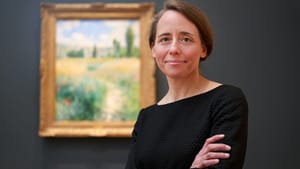Stay in the Loop
BSR publishes on a weekly schedule, with an email newsletter every Wednesday and Thursday morning. There’s no paywall, and subscribing is always free.
More than a coat of paint
A curator’s tour of the new European galleries at the Philadelphia Museum of Art

With the pandemic shutting down all the city’s cultural institutions, visitors don’t know when they’ll have a chance to see the reimagined core spaces still under construction at the Philadelphia Museum of Art. In anticipation of the grand reopening, however, the PMA has reinstalled its galleries of 19th-century European art, with some noteworthy surprises.
For Jennifer Thompson, PMA curator of European painting and sculpture, the time had come to rethink those spaces. “When you come in the new West entrance you are going to come up the stairs right into these galleries that were installed 25 years ago.” Now, with a new coat of paint, new groupings, and new wall panels with text explaining the theme of each room, they’re ready for a grand entrance.
The red century
Thompson and I were on the telephone, discussing the closed galleries from memory. The first thing I had noticed on a March visit was the walls, which have joined a parade of museums abandoning a flat, nearly-white look for vibrant colors. The deep red (called “burnt russet”) works well for the Academic paintings. Artists created these more conservative works for massive sales events at the annual Paris Salon exhibition. Paintings hung floor to ceiling on walls that were generally painted red or green, and the artists created pieces that worked well with the background to entice buyers.
Sometimes artists used just a sparing touch of red, keyed to the presentation color. Eduard Charlemont’s Moorish Chief hangs framed in the entrance to gallery 255, flowing white robes slashed with that touch of red on the scabbard. The figure leaps from that deep red wall, and we almost expect him to stride away on business of his own at any moment.
When Charlemont finished the piece in 1878, the title was The Harem Guard, but Thompson said that was edited out by 1917. “It is more than the artist intended; it has become something else.” The painting has invited generations of school children to imagine what is going on, and Thompson added, “It’s pretty magical that it hasn’t gotten so rooted in its [Orientalist] historical context, that it has been able to invite other interpretations.”

What Manet wanted
When I last visited in March, I headed straight to the Rotunda to say hello to some of my favorites. Here, too, the pale walls had been transformed with a saturated grayish-blue paint. I should not have been surprised; in 2011 the Musée D’Orsay, Paris’s showcase museum of 19th-century art, adopted almost identical colors. It’s a trend. More shocking, Edouard Manet’s Le Bon Bock, the portrait of a robust burgher with a pipe and glass of bock beer, was missing! I didn’t expect to find him in gallery 255, sharing a wall with The Moorish Chief, but Thompson seemed gleeful when she admitted, “I was being very provocative in putting him in the Salon, particularly the Bon Bock. That was Manet’s first true Salon success.”
Manet was influenced by the old masters in this painting, so it never quite fit in with his impressionist work, but there was more to Thompson’s decision: “[Manet] wanted to show all of his work at the Salon. He felt that was the place he could be most effective as a revolutionary and sort of ruffle feathers. And I needed to honor his desire to compete in the Salon.” Still, she promises that he will move again in the future to reflect the life of his work among the impressionists as well as the Salon.
Knowing where to look
The reinstallation freed Thompson to integrate the Carroll S. Tyson, Jr. collection into the museum’s other holdings. Breaking up the collection allowed her to create new juxtapositions: setting Le Bon Bock in the Salon, but also creating a wall of Van Gogh. It brought Berthe Morisot’s Young Girl with Basket into, and moved one of my least favorite pieces out of, the Rotunda.
Renoir’s Still Life with Flowers and Fruit always seemed overripe in subject and style. It now shares gallery 265 with Vuillard and Bonnard, among others, but Thompson has hung it well above eye level: “It needs to be seen from below because there’s a trompe l’oeil effect when you are looking up at the underside of the vases.” Unlike most of the hanging art, it was created for a specific space, which may explain the striking color palette.

“We don’t know the house that it was designed for, but I can only imagine he might have been trying to compete a little bit with the architecture,” Thompson said. “We know that it originally had a notch out of it. It is essentially a U-shaped picture that fit around a ceiling beam of a house. It literally encircled some of the architecture in the room.” When Tyson purchased the painting, he had a restorer fill in the notch so that it could be hung in a frame on a different wall. The notch is easy to find if you know to look for it.
Art on the Parkway
The Benjamin Franklin Parkway is home to some of the greatest 19th-century art in the world. So I had to ask Thompson whether she saw the PMA’s collection in dialog with the Barnes down the street. She sees the two collections as complementing each other, with more Monets and Van Goghs in the PMA collection, but they agree on Cézanne. “Between the PMA and the Barnes Foundation, we have more Cézannes in Philadelphia than they have in Paris," Thompson said. "When you get to Cézanne’s Large Bathers, you can’t help but be aware of the other great painting [in the set] that is just down the Parkway.” That’s why she decided to make a gallery focused on Cézanne, with texts that explain what he was trying to do. That will change in time, too, but for now, the museum, with its treasures, awaits.
Sign up for our newsletter
All of the week's new articles, all in one place. Sign up for the free weekly BSR newsletters, and don't miss a conversation.

 Camille Bacon-Smith
Camille Bacon-Smith